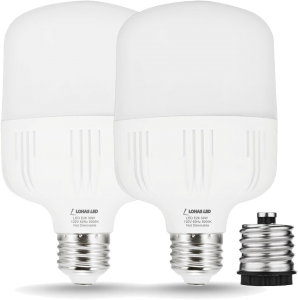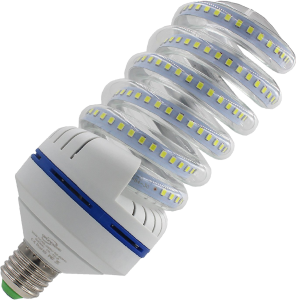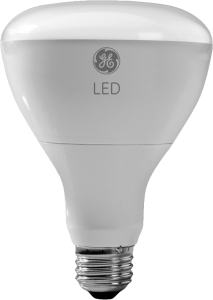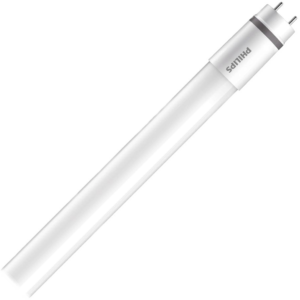Swapping out those old incandescent bulbs for alternatives like LEDs? Us too. Over the past couple of weeks, we ramped experimentation in laundry rooms, garages and hallways to improve illumination in those often tough-to-light areas. What we found is this brave new world of LED lighting requires that you pay attention to a range of new variables rarely considered in the old world of straight-up incandescent or even fluorescent lighting. These days, you must map wattage equivalents to determine brightness, color temps, base types and a whole range of other variables to ensure those LEDs will work in your old fixtures.
The table below shows where we focused for this particular test. Couple of quick notes. We list both Lumens and Lux in the chart. Lux (which takes into account the physical space) helped us determine how the lighting in our specific locations was improved when swapping out old lights for new. These comparisons showcase the relative impact of each option (and of course, your mileage, in your specific areas, will vary).
[table id=1 /]As you can tell, we mostly looked for near-daylight equivalent options in the 5000K color-temp range or higher. Numerous options exist from a range of well-known and alternative brands.
Here’s a quick rundown of some winners and losers, and a few key lessons learning in this process.
LOHAS LED 30W Commercial Retrofit Light Bulb

This brand and their 250-300W equivalent bulb quickly emerged as a favorite in our test. We used them in the garage to replace the old spiral 32W CFL bulbs. Those old warm white products had the output of a 125W incandescent fixtures and just no longer cut it for the space. The new LOHAS LEDs blew them away both in brightness taking the illumination in the space from roughly 200 Lux to that approaching 700 Lux or a 3x improvement. Wow! The new daylight color (5000K) made a huge difference too. These provided a very even 240 degree lighting pattern both directly below and to the sides of the lamp unlike some other spiral shape LEDs (like the CFLs). Available in a two-pack from Amazon for about $30.
OUYIDE 30W LED Corn Light Bulb

These spiral “corn” lights boast a very bright daylight white (6000K) color temp and purport to provide the equivalent of a 250W incandescent light. Unfortunately because of that spiral shape, much of that value is wasted, projected out to the sides of the lamp and away from the area directly below. The manufacturer claims a 300 degree beam angle. Yeah, sort of. Assuming you don’t need any direct task lighting underneath, and have numerous fixtures these might work fine. But for us they delivered lighting that offered no improvement over the CFLs. The OUYIDE 30W lights are also more expensive at almost $19 per unit at Amazon.
GE Lighting 22726 LED 10-Watt Floodlight

The GE 10W LED Floodlights represent a solid offering from the company known for their lighting products. They’re the same shape and size as those they replace and fit in the old fixtures perfectly, as you’d expect. The company offers several color temp options and like everything in this test, we opted for the daylight version at 5000K. We got 200-300 Lux from these in a hallway and were very happy with the overall brightness improvement over the old 65W incandescents. Two-packs at Amazon are around $12.
TIWIN 11W General Purpose Light Bulb

Another solid and very straightforward light bulb, the TIWIN 11W product provide the equivalent of 100 incandescent Watts. We went with daylight (5000K) option like everything else in this test, but soft (warm) white is also available. These bulbs don’t dim. We tried and they flicker like mad when using them on a dimmer switch. On or off is your only option with the TIWIN 11W General Purpose Light Bulb. Put them in a garage door opener — as we did — and you won’t be disappointed. Perfect, nearly omnidirectional light is what you get. Lux value approached 700 for two bulbs. Available in one, three and six packs at Amazon. Around $7 per unit.
Philips 20W 48-inch LED Tube

Unlike replacing an old incandescent bulb, retrofitting fluorescent tube fixtures present a slightly bigger challenge. Most of those using the 1.5-inch tubes known commonly at T12. Most LED bulbs come in the narrower T8 diameter and can require rewiring the fixture to eliminate the original ballast. Others don’t and the Philips 20W LED Tube is one of those. Just twist and pull the old 48-inch fluorescent tubes from their mounts and replace with the new LED versions. We went with the 6500K daylight, an eye-popping option giving us about 800 Lux per tube. Massive improvement — almost four or five times the brightness — over the old lamps. About $15 at Amazon.





